Menu
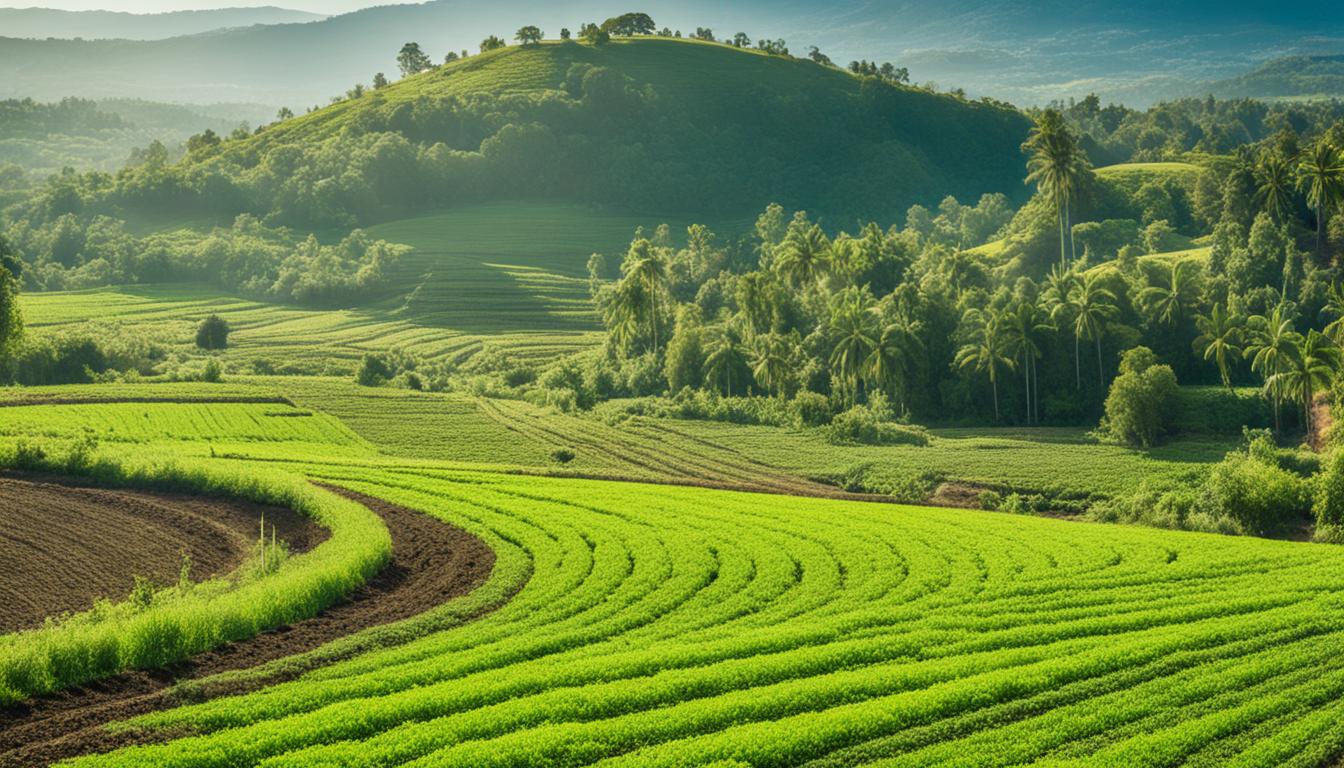
Healthy soil, packed with organic matter, can cut down on the need for more farming inputs. This shows how vital it is to care for our soil sustainably. By bolstering the land’s natural strength, using sustainable soil methods makes farming more efficient. Across the US, from Alabama to Wyoming, the USDA is leading in teaching practices that protect soil. It’s about disturbing the soil less, keeping it covered, and encouraging diverse life in the soil.
Specific plans are in place to nourish our soil. For example, rotating crops brings a variety of nutrients to the soil. This helps different crops grow well without extra fertilisers. Cover crops, like triticale, rye, or barley, stop soil from washing away in winter. Terracing on steep fields and windbreaks also help to keep the soil in place.
Growers using these methods not only keep their soil healthy but also make more money from their crops. It’s all about caring for the land in a way that lasts. This approach focuses on the long game of farming and soil health.
Soil is crucial for life, hosting over a quarter of Earth’s biodiversity. It plays a key role in farming by preventing erosion, improving water flow, and managing key nutrients. Almost all our food, more than 95%, comes from healthy soil. This underlines its importance for food security worldwide. Healthy soil also means farmers can spend less on outside chemicals and inputs.
Good soil health prevents erosion and pollution, preserving its fertility. It’s full of organic matter which helps plants grow stronger and handle tough conditions. It’s home to many helpful creatures and microbes that cycle nutrients. This ecosystem keeps the soil fertile, boosting crop yields and farm sustainability.
Soil is vital for growing food and battling climate change. It stores a lot of carbon and is key for 95% of our food. But, more than half of farm soils are damaged. To fix this, we must use fewer chemicals and more environmentally friendly practices. This move ensures our farms can keep producing, no matter the future challenges.
Minimising soil disturbance is key in sustainable farming. This includes reducing tillage and using fewer chemical inputs. These steps help keep the soil healthy.
Frequent tillage causes soil compaction and structure damage. By cutting down on tillage, farmers protect soil spaces. This helps water and air move through the soil better. No-till and minimum tillage methods preserve soil health, cut down erosion, and save time and energy.
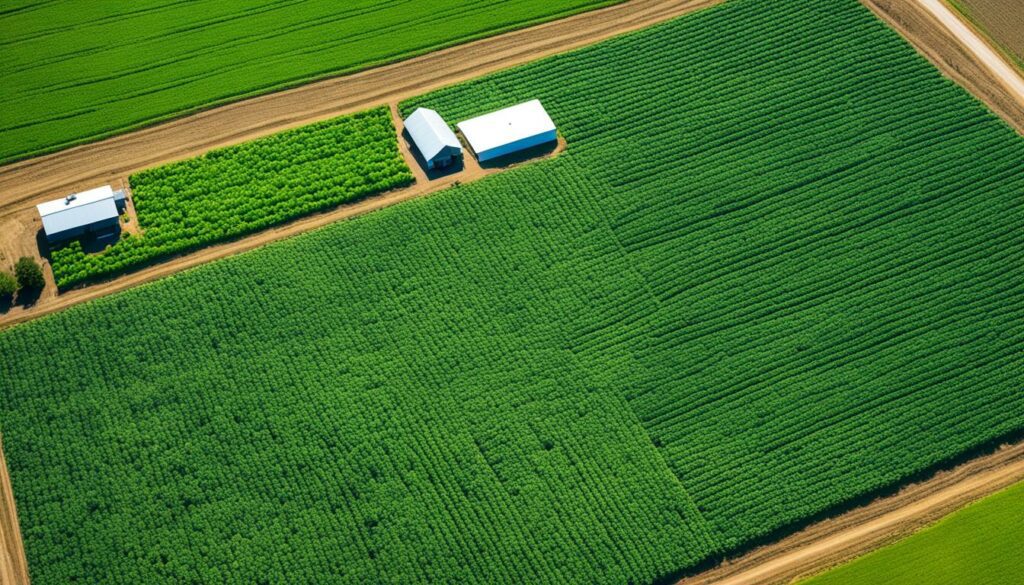
Too many synthetic fertilisers and pesticides can hurt soil life. It’s important to use fewer chemicals and more natural methods. Adding things like compost and manure can cut down on chemicals. This helps keep the soil ecosystem balanced.
Moving animals around crops can aid soil health. It prevents soil compaction and spreads nutrients. This also disrupts pests and diseases. Good livestock rotation boosts soil life and supports organic farming’s diversity focus.
Using these methods creates rich soil. This way, farming can stay sustainable for the long run.
Looking after soil cover is key to keeping it healthy. There are many ways to make sure the soil stays covered. This stops soil erosion and is great for organic farming.
Cover crops help soil by stopping erosion and doing other good things. They slow down the rain, which stops soil from splashing. It also helps water get into the ground better. This way, less nutrients wash away with the water.
Farmers like to use legumes in their mix because they help keep the soil healthy. Legumes work with a special kind of bacteria that gives the soil more nutrients slowly. This means farmers don’t need to use as many artificial fertilisers. It fits well with organic farming because it’s a natural way to keep the soil rich.
Putting down organic mulch helps the soil stay safe. It stops water from evaporating and keeps the ground moist. This makes it hard for weeds to grow. Mulch also makes a good home for tiny organisms that help the soil stay healthy.
Using mulch is also good for the environment and makes farming last longer. It keeps the ecosystem in balance. This is another way organic farming is good for the planet.
Leaving old plant parts on the soil is good for many reasons. They stop the wind and rain from moving the soil around. Also, they help keep the soil full of important stuff like carbon and nutrients. This makes the soil better for plants to grow.
Leaving the plant bits also lets helpful insects live there. This is good for the environment. It matches well with keeping the soil from eroding and making the most of cover crops.
| Method | Benefits | Challenges |
|---|---|---|
| Planting Cover Crops | Reduces erosion, improves fertility, increases biodiversity | Requires careful planning and management |
| Using Organic Mulch | Reduces evaporation, suppresses weeds, enhances microbial activity | Needs consistent replenishment |
| Leaving Plant Residue | Prevents erosion, adds organic matter, promotes biodiversity | May harbour pests if not managed properly |
These methods are great for keeping the soil safe. They help reduce soil erosion and make the most out of organic farming. If we use them well, they make our farms healthier and stronger.
We need to know why soil biodiversity is so important. It contains over 25% of all life. This life is crucial for both plants and the earth’s climate.
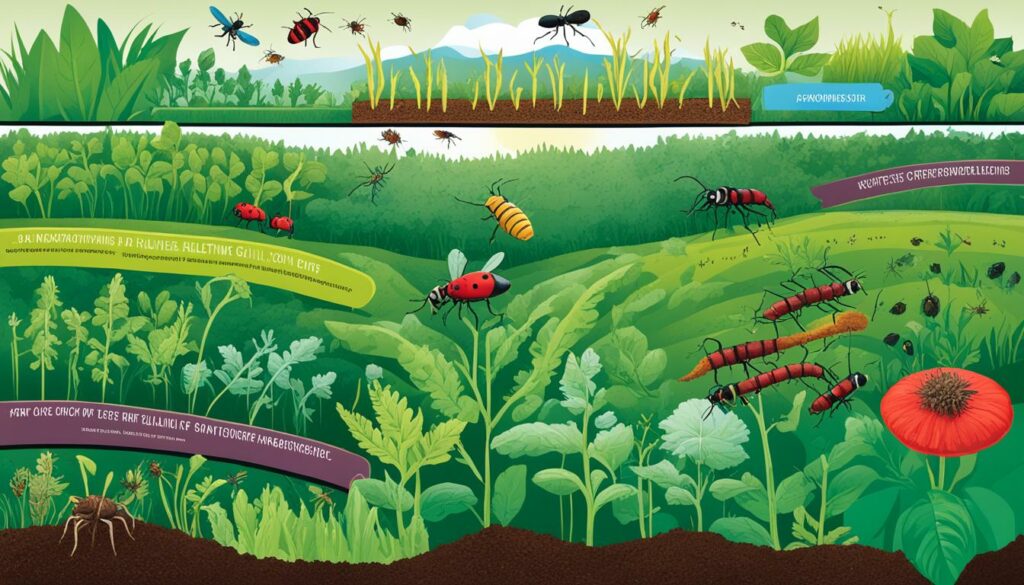
The Global Soil Biodiversity Initiative aims to spotlight soil biodiversity. *Its first big study* found that more than 30% of species are at risk or gone. This shows we must act fast.
Action is needed to boost soil life. This includes saving natural areas and using better farming methods. It also means creating more green spaces in cities. These steps help keep soil life thriving for our children.
Some good farming methods are cover cropping and agroforestry. These methods use soil life to grow better food and protect farms. Most farmers like these methods because they also help with crop insurance.
But, soil life is in danger from climate change and other threats. We must keep checking and protecting it. Doing so will help us make better choices and investments for the earth.
Soils are home to more than half of the earth’s remaining life. Investing in them is essential for the future of our planet. It’s more than just a farming issue; it’s about keeping our whole environment in balance.
Using sustainable soil practices is key for healthy farmlands. It involves techniques that keep soil disturbance low. Methods like crop rotation and composting help improve soil health. These methods follow regenerative agriculture principles. They aim to keep soil covered and increase its organic matter.
Good soil has a mix of minerals, air, water, and organic matter. Many living things call it home, including earthworms and bacteria. This biodiversity is vital for the soil’s health and helps with nutrient cycling.
Even sandy soils can be made better by adding organic matter. Loam soils, with an equal mix of sand, silt, and clay, are perfect for growing. They hold nutrients well.
Sustainable soil practices benefit the whole ecosystem. For example, earthworms help water soak into the ground. This makes the soil better at holding water and stops erosion. This all helps the soil deal with extreme weather.
| Soil Component | Percentage |
|---|---|
| Minerals | 45% |
| Air | 25% |
| Water | 25% |
| Organic Matter | 2-5% |
| Soil Life | Weight (per acre of topsoil) |
| Earthworms | 900 lbs |
| Fungi | 2,400 lbs |
| Bacteria | 1,500 lbs |
| Protozoa | 133 lbs |
| Arthropods & Algae | 890 lbs |
Choosing organic farming and sustainable soil techniques is vital. They secure a strong agricultural future. These methods help increase crop harvests, preserve biodiversity, and protect our soil for the next generation.
Carbon sequestration in soil is key for fighting climate change and keeping soil healthy. In the last 12,000 years, about 133 billion metric tons of CO2 have gone from the soil to the air because of farming. It’s vital to manage soil health well for farming that lasts and a stronger environment.
Organic matter is vital for storing carbon in the soil and making it better. It makes the soil hold water, keeps it fertile, and helps its structure. Sadly, up to 70% of the organic carbon in farmed soils has vanished. But, we can turn this around with good soil care, promoting better farming methods.
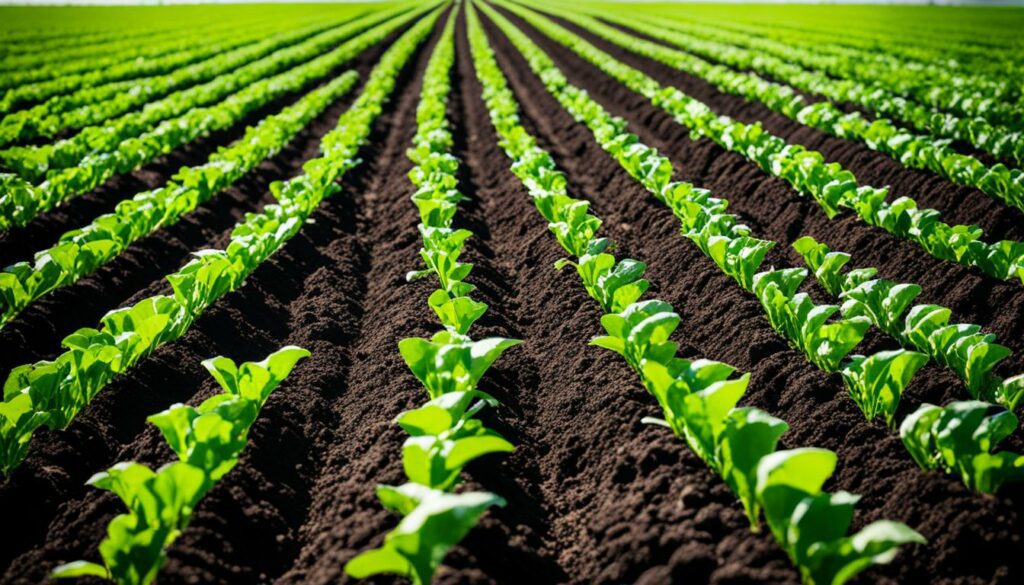
There are many ways to boost carbon sequestration in soil. For example, keeping roots in the ground and using cover crops. This not only adds organic matter to the soil but also cuts down on CO2 in the air. Experts believe global efforts could help store up to 5.3 GtCO2 each year by 2030.
| Statistic | Detail |
|---|---|
| CO2 Released | 133 billion metric tons over 12,000 years |
| Organic Carbon Loss | Up to 70% in some cultivated soils |
| Sequestration Potential | 5.3 GtCO2 per year by 2030 |
| Agricultural Emissions | 5.0–5.8 GtCO2-equivalents per year (2000–2010) |
| Carbon Credit Price | $15–$20 per metric ton |
| Implementation Cost | US$100 per ton of CO2 |
| U.S. Farmland Rented | Almost 40% |
| Senate Passage | The Growing Climate Solutions Act |
It’s really important to use all the ways we have to store carbon in soil. Since 80% of the world’s soil carbon sits in the ground, and it’s 3.1 times more than what’s in the air, taking care of the soil is essential. It will make a big difference in farming and in fighting climate change.
Using the right techniques to prevent soil erosion is key. It keeps the soil healthy for growing crops over time. In the Midwest, half the topsoil has been lost in 50 years, mainly due to man-made erosion. Places like Iowa have lost a lot of topsoil since 1850. It emphasises the urgency to act now.
There are many ways to keep the soil safe from erosion. Methods such as terracing and planting certain crops help a lot. For example, planting crops like corn on the same level can reduce erosion. This is because leaving leftovers of these crops on the soil acts as a shield against strong rain and winds.
Also, planting cover crops when the main crops are not growing can help. These cover crops are usually grasses, grains, and legumes. They form a natural barrier against erosion caused by the wind and rain.The price to set up things like hedges to stop erosion costs between $50 to $100 per mile. Cover crops are cheaper, costing between $10 to $40 per acre, based on the seed type.
No-till farming and similar ways of farming also help a lot. They keep the ground covered in old crops, which stops erosion. This protects the soil and makes it more productive.
Erosion costs the US around $37.6 billion in lost crop value every year. Most of the soil that washes away ends up in water, harming the environment. The Midwest saw a lot of heavy rains in 2019. This caused a big amount of erosion.
It’s vital to use sustainable soil practices to lessen erosion. Methods like planting hedges and farming in certain ways can cut down on soil loss. These ways not only save soil but also bring many other good things. Like better crops, clean air and water, more places for animals, less work for farmers, and healthier soil.
| Technique | Benefits | Cost Range |
|---|---|---|
| Vegetative Barriers | Reduces wind and water erosion | $50 – $100 per mile |
| Cover Crops | Protects soil and increases fertility | $10 – $40 per acre |
| No-Till Planting | Preserves residue and limits soil disturbance | Varies |
| Terracing | Reduces water runoff on slopes | Varies |
So, it’s smart to invest in ways to stop erosion. These measures are crucial for the success of farms in the future. Support from places like Heritage Land Bank can help make sure these important steps are taken to keep our land productive for a long time.
Proper soil nutrient management is key to high yields and eco-friendly farming. Farmers check the soil’s nutrients carefully through tests. This lets them use the best fertilisers for their crops. The “Four Rs” help farmers apply the correct amounts of nutrients. This method boosts crops’ use of nutrients and helps protect the environment.
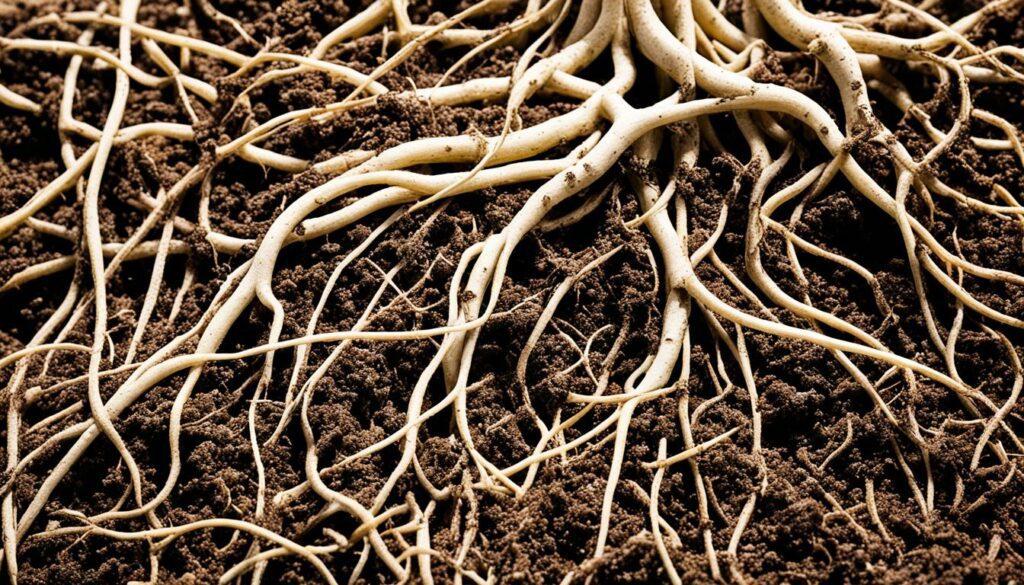
Using both organic and chemical fertilisers wisely is important. Nutrients like nitrogen, phosphorus, and potassium are essential for crops. But, too much of them can harm the environment. Natural methods like green manure and compost help keep the soil healthy. They reduce the need for harmful chemicals.
| Balanced Fertilisation Techniques | Benefits |
|---|---|
| Right Rate | Prevents over-application and nutrient run-off |
| Right Source | Enhances nutrient availability specific to crop needs |
| Right Time | Synchronises nutrient release with crop uptake |
| Right Placement | Maximises roots’ nutrient absorption |
Cover crops and natural fertilisers help with soil nutrients. Plants like legumes add nitrogen to the soil. Using compost and manure makes the soil healthier. This way, farmers rely less on chemicals and the soil stays fertile for longer.
Cover crops are key to keeping our soil healthy. They make the soil better and help crops grow. In 2017, farmers used them on 15.4 million acres, which was 50% more than five years before.
There are many types of cover crops, which can do different helpful things. For example, legume cover crops can add a lot of nitrogen to the soil. This means farmers don’t need to use as much nitrogen fertilizer. Non-legume cover crops can also help by using up some of the extra nitrogen.
Using a mix of cover crops, known as “cocktails,” can do even more. It can make more plant material, help control weeds, and attract good bugs and pollinators. But, these mixes can be harder to manage.
Picking the right cover crop for the season can really boost your farm. For instance, during a drought in 2012, cover crops helped increase corn and soybean yields. They can make the soil healthier and even increase how much you grow.
In the Northeast US, heavy rains are causing soil and nutrient loss. Cover crops help by keeping the soil in place, holding onto nutrients, and stopping some pests. They also keep the soil moist, making it better for growing crops.
Cover crops are great for farmers in many ways. They help you grow more, spend less on machinery, and fight against weeds and diseases. Even though they may cost more at first, they are smart in the long run. Help and advice on using cover crops are easy to get from places like universities and the USDA.
A key method in regenerative agriculture involves pairing livestock with crops. This system, known as integrated livestock management, boosts soil health and fertility. It forms a cycle where animals enrich the land by recycling nutrients and adding organic matter.
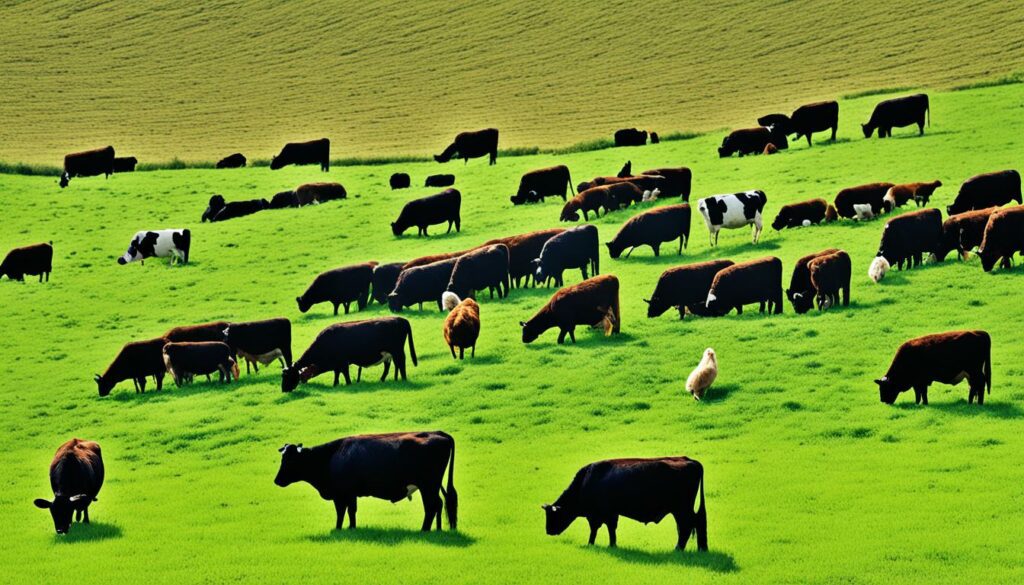
Livestock, when part of a farm, naturally fertilises the soil with their manure. In the U.S., farms that raise poultry, beef, and hogs often use concentrated feeding operations (CAFOs). These places need a lot of feed, which ups the use of fertilisers on crop fields. Yet, managing livestock right can make their manure a vital source of nutrients like nitrogen and potassium for about $25 billion yearly.
Grass-eating techniques, like mob or rotational grazing, are crucial for regenerative farming. They break pest cycles and protect the soil from erosion. For example, letting livestock graze in off-seasons can cut down on pest insects and pull up weeds. This way, the land does not just fight pests, but also becomes more fertile and keeps more moisture.
The value of manure in terms of money is huge. The waste from a 100-cow dairy farm can be worth more than $20,000. How and when this manure is spread is key to getting the most out of it. This boosts the soil, helping crops grow better and healthier.
| Benefits | Integrated Livestock Management |
|---|---|
| Soil Health Improvement | Enhances organic material, reduces erosion. |
| Natural Fertilisation | Provides essential nutrients, boosts fertility. |
| Pest and Weed Control | Disrupts pest cycles, reduces weed problems. |
| Economic Value | Manure valued at $25 billion annually in the U.S. |
Integrated livestock care also keeps more nutrients on the farm, especially if the main sales come from animal products. This way of farming makes things more stable when markets change. It ties together growing crops and raising animals, improving the land and saving money by needing less feed and fertilisers from outside.
Cutting down on tillage is vital for keeping soil healthy. It helps keep the ground rich in nutrients. This method also keeps moisture in the soil and allows plants and wildlife to thrive. No-till farming is especially good at this and brings new, smart ways to farm.
No-till farming stops the soil from washing away or getting damaged by too much ploughing. Farming this way over almost a third of the land can make a big difference. For instance, in California, nearly half of the fields were farmed like this by 2010. This kept the air and water clean, and made sure farms stayed productive.
This way of farming saves farmers a lot of money, because they use less fuel and have lower costs. Doing 40% fewer ploughing rounds means saving on energy and also keeping the soil under the ground healthy. It also helps water flow better and creates homes for good bugs and animals.
New ways to farm without tilling the soil are getting popular. For example, roller crimpers let farmers deal with cover crops without ploughing. This gentle method keeps the soil strong and helps crops grow well. More and more land is being farmed this way, aiming for over half to be no-till by 2028. This shows how well these no-till methods work.
New tools and methods are making it easier to farm without ploughing. Things like better machines, planters, and ways to manage weeds mean we can take better care of the soil. Thanks to these, farmers like Si Zhanxin saw their wheat production go up by 10-20% in just one year, proving that no-till farming works well.
| Method | Conventional Tillage | No-Till Systems |
|---|---|---|
| Tillage Passes | Multiple | Reduced by 40% or more |
| Soil Erosion | High | Low |
| Fuel Expenditure | High | Low |
| Water Infiltration | Poor | Improved |
| Soil Compaction | High | Low |
Soil health indicators help us check how well we’re doing with sustainable farming. Before, we only cared about physical and chemical properties. But now, knowing how the soil’s living parts work is key.
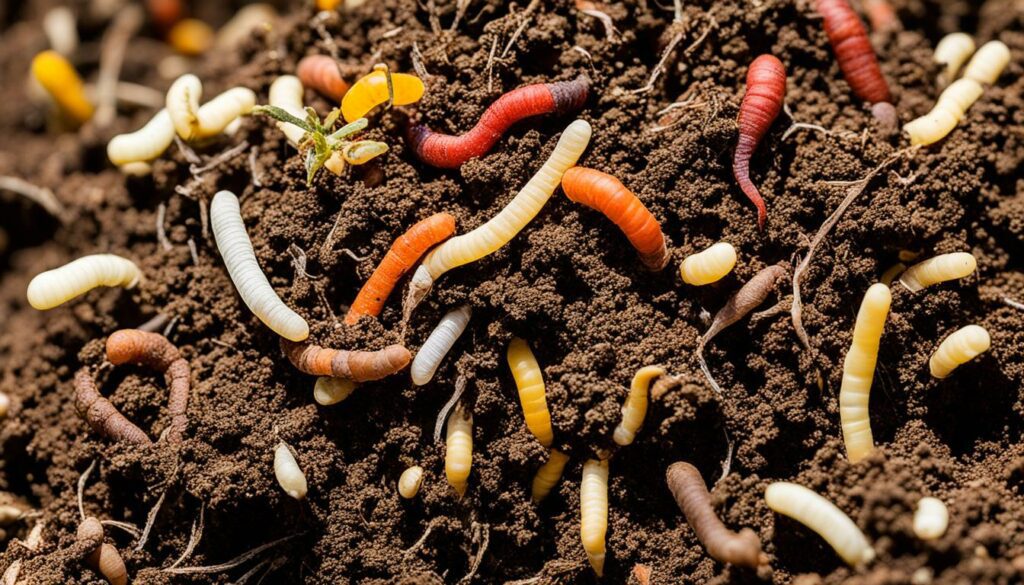
Soil life, like bacteria and fungi, is very important. They break down waste, cycle nutrients, save carbon, and shape soil. By looking at these creatures and what they do, we learn a lot about the soil’s health and strength.
Soil’s look and how it breaks are also key signs. No matter how we farm, soil type stays the same, making it easy to see changes. Strongly sticking soil means it’s less likely to wash away. This helps air, water, and nutrients flow better, which is really important for farms to grow well.
The pH level and how well soil holds nutrients matter for plant growth. Nutrients are best used when the soil’s pH is just right. Also, healthy clay soils hold on to and share nutrients better than sandy soil does.
All the small life in the soil makes it strong against harm. If the soil’s alive and kicking, it’s likely doing well. The stuff it’s made of helps these small lives grow. This is really important for the soil to be healthy.
“Our soils are not just dirt; they are vibrant ecosystems. Measuring soil health indicators enables us to nurture these living systems for long-term sustainability.”
We use special ways to tell how healthy soil is. We look at how well it uses food, moves nutrients, stays together, and keeps carbon. Knowing these things helps farmers do better, nature-friendly work. The US Department of Agriculture really focuses on keeping soil healthy for good farm productivity.
| Soil Property | Importance | Impact |
|---|---|---|
| Soil Texture | Constant measurement of sand, silt, and clay | Affects water retention and root penetration |
| Aggregate Stability | Resistance to erosion | Enhances nutrient retention and aeration |
| Soil pH | Neutral pH enables nutrient availability | Optimises plant growth and health |
| Microbial Biomass | Indicator of soil biodiversity | Enhances resilience to environmental stresses |
| Soil Respiration | Indicates biological activity | Reflects soil organic matter decomposition rates |
| Cation Exchange Capacity | Soil’s ability to retain and release nutrients | Improves fertiliser efficiency and soil fertility |
It’s key to understand and check soil health markers for good sustainable farming. These measures give us a way to be sure our soil is doing well. This helps us make choices that are good for both farming and nature, so everyone wins.
Regenerative agriculture is all about making the land healthy again. It focuses on the soil and the whole environment of a farm. This is done by disturbing the soil less, adding more organic material, growing different crops each season, and including animals in the farm life. These practices help the land become stronger and able to renew itself. This brings a lot of benefits to the soil.
Regenerative agriculture has key ideas that make farms last longer and be better for the planet. It means not disturbing the soil much, like in no-till farming. This helps keep the soil in place and lets water sink in better. Such steps also help trap carbon, which is good for the atmosphere. By using cover crops, up to 85% of new U.S. farming land could take in about 100 million tons of carbon dioxide every year. Yet, only a small part of American farms are using cover crops right now.
Regenerative practices are great for the ground. Cover crops make the water cleaner and the soil healthier. By planting different crops in turns, the need for harmful chemicals goes down. More life in the soil means better plants, bigger harvests, and lots of small helpers like bacteria and fungi. These changes help fight climate change and make farms more able to cope with problems.
| Principles | Benefits |
|---|---|
| No-till Agriculture | Reduces soil erosion, encourages water infiltration |
| Cover Crops | Improves soil health, reduces water pollution |
| Diverse Crop Rotations | Lowers pesticide use, increases biodiversity |
| Integrated Livestock | Enhances nutrient cycling, natural soil fertilisation |
Use of regenerative methods comes with challenges too. Sometimes they can change how much is harvested. The success can also depend on where the farm is and what the weather is like there. Although there are some barriers, with more research and smart planning, regenerative agriculture is a bright way forward for farming.
Organic farming is all about the long game. It focuses on keeping the soil healthy and nature in balance. Natural soil amendments and sustainable pest control are key. They help farmers keep their land fertile and productive for years.
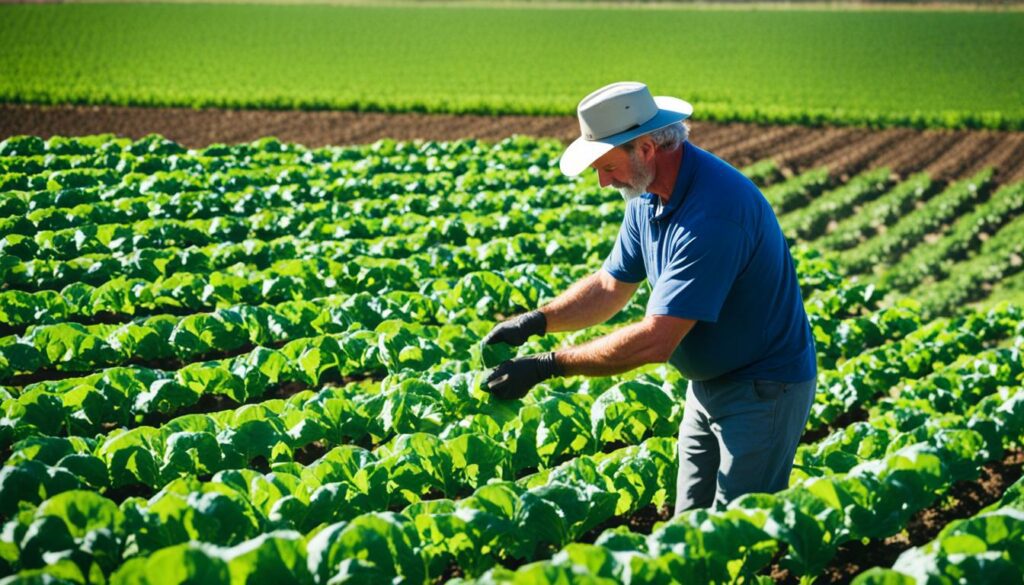
Natural soil amendments like compost and green manure are vital in organic farming. They bring back key nutrients to the soil. This improves soil structure and boosts helpful microorganisms.
In Georgia, many soils lack organic matter from past farming practices. Adding these amendments works wonders for soil fertility there.
Rotating crops is crucial. It involves not planting the same family on the same spot for about eight years. This method cuts down on pests and diseases, helping the soil stay healthy. The USDA suggests aiming for 3% organic matter in the soil. Using these methods regularly can hit that target.
| Amendment Type | Source | Benefits |
|---|---|---|
| Compost | Organic Waste | Enriches Soil, Enhances Microbial Activity |
| Biofertilisers | Microorganisms | Promotes Nutrient Availability |
| Green Manure | Cover Crops | Improves Soil Structure, Adds Organic Matter |
Organic farmers tackle pests and diseases with care, avoiding synthetic pesticides. Sustainable pest control means using methods like IPM. It involves natural enemies for pests and diverse crops. This keeps their fields healthy and free of harmful chemicals.
To protect crops, buffer zones are set up. These zones can span 25 feet, keeping organic fields safe from non-organic neighbours. The USDA also ensures organic products meet high storage and processing standards.
Organic farming techniques are more than green ways to farm. They protect our food and the planet. By using natural means to enrich the soil and control pests, we build a stronger agriculture.
One key to sustainable soil management is fitting farming methods to the local area. This involves understanding the unique issues and opportunities different places offer. It means considering the climate, types of soil, and the kind of crops grown there.
In places like southern Europe and Asia, terraces have helped grow crops for centuries. It’s crucial to use methods like this for the best soil health. In the United States, windbreaks with several rows of trees slow down the wind. This helps keep the soil in place, preventing erosion. These examples show how important it is to match soil practices with local needs.
No-till and reduced-tillage methods are great for preventing erosion. They also make good homes for wildlife. They work well in areas where the top layer of soil is where most carbon is found. Farmers in these places are using plants, like certain types of grass, instead of tilling soil to control weeds.
Cover crops are important for many reasons in different places. They stop the soil from washing away, stop nutrients from leaving, and help other plants grow. In wet areas, planting crops like triticale slows down the rain. This helps stop erosion. It’s important to use what works locally for the health of the soil and the environment.
These crops’ roots help water soak in, lessening how much runs off. In dry areas, planting legumes helps because they add nitrogen to the soil. This supports plants’ growth. Using a mix of different plants can also attract helpful insects. For example, in California, mixes are made to help bees in almond orchards.
“Conserving soil biodiversity through adapted practices not only reinforces sustainable soil management but also enhances overall agricultural resilience.”
With so much land already used for agriculture, there’s not much room for more. So, it’s crucial to use what we have wisely. Some ways farmers can do this include growing more than one type of crop and farming in ways that work with the climate.
Farmers use technology to farm smarter, for example, by checking the weather with special apps. In the United States, there are also programs that help farmers protect the land and their crops from the weather.
Farmers everywhere are facing new challenges due to changing climates. But, by being smart and sharing what they know, they’re finding ways to keep going. Working together helps everyone take care of the soil and grow food in a way that’s good for the planet.
There are many challenges in front of us today. It shows us that we must adopt new ways to take care of our soil. Shockingly, we lose about 24 billion metric tons of soil each year to erosion. This shows us how critical our global soil situation is.
About 30% of soils worldwide are damaged. This directly affects how much food we can grow. It also makes problems like not having enough food worse. The number of people not getting enough food rose by 5% from 2015 to 2017, now at 821 million.
Soil health is really important for many United Nations’ goals. These include ending hunger, improving health, ensuring clean water, and fighting climate change. By taking care of our soil, we can help a lot with these goals.
China’s soil problem makes this issue urgent. About 19% of its soil doesn’t meet their standards. This shows that soil issues are global, not just in one place.
Soil science and sharing important knowledge are key parts of the solution. The more carbon dioxide in the air is causing climate change. This means we need new and smart ways to take care of the soil.
We need to use good soil care methods in farming. This includes looking after the nutrients in the soil, stopping erosion, and supporting more plant and animal life. By doing these things, we can keep our land healthy for many years to come.
Sustainable soil practices keep the soil healthy by avoiding over-disturbance. They include keeping soil covered and promoting diversity in it. These methods are key for long-lasting and strong farming.
Healthy soil supports crops by recycling nutrients and allowing water to soak in. This reduces the need for outside help in growing plants and helps crops cope with tough times. Methods to save soil and manage nutrients are essential for good farming.
To keep soil healthy, try not to disturb it too much. This means using less machinery, being smart about chemicals, and moving animals around. Such steps are crucial for keeping the soil alive and well for farming.
Cover crops stop soil from washing away, make the soil better for planting, and help more plants and animals to live there. By planting these helpful crops and using natural mulch, the soil is protected and made stronger, making farming more sustainable.
Looking after different cover crops, changing what you plant, and including animals on the farm boost life in the soil. This is important for keeping the soil naturally rich and for controlling pests and diseases.
Carbon sequestration means trapping carbon in the soil to help fight climate change. Using methods that keep the soil always covered and planting certain crops can do this. It’s a natural way to lower the impact of climate change.
By using farming designs, like steps on slopes, or leaving trees and bushes in certain patterns, you can stop the soil from being washed and blown away. These methods protect the land and help farmers grow better crops.
Looking after the soil’s nutrients with natural ways, such as planting certain crops, is better for the earth. This way enriches the soil without using too many man-made chemicals.
No-till farming is good for the soil because it stops the land from washing and blowing away. It also helps water go into the ground better and creates homes for animals. New ways of farming keep the soil healthy without ploughing it.
Soil health is shown by how the soil looks, how much life is in it, and how well it can grow things. Keeping an eye on these signs helps farmers know if they are doing things right for the land.
Regenerative farming means playing softly with the soil, adding more to it, switching up what you plant, and including animals. These ways make the soil better and the farm stronger, supporting the future of farming.
By using things from nature, like compost, and by not using harmful chemicals, organic farming helps the soil and everything that lives in it stay healthy. It’s about working gently with the land.
To farm well, you need to know your land and what it needs. Working with the weather, soil, and crops where you are helps the soil stay good for a long time. It’s about caring for the land in the best way for your area.